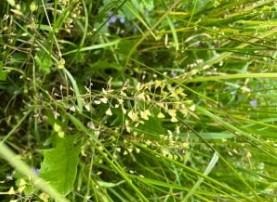By Haley Zynda
As someone with grazing livestock, I’m always checking the fields and trying to identify the non-grass plants that may pepper the pastures. Weeds in a pasture are detrimental – something as seemingly harmless such as reducing the available dry matter to potentially poisoning the stock if they get into the weeds for a taste-test.

Shepherd’s purse prefers full sun and rich soils and can be found in ag crop fields, gardens, lawns, and roadsides.
The three weeds of interest in this article are field pennycress, pepperweed, and shepherd’s purse. They all have varying levels of toxicity and have a very distinct seed head that can easily be confused for one another. All three weeds are winter annuals in the brassica family, so they begin germination in the cold months, bolt by May, and fizzle out by June to let the summer annual weeds have their turn in the weedy spotlight.
We can start with field pennycress. Its Latin name is Thlaspi arvense L., but other common names include stinkweed, fan-weed, and French-weed. It originated in Europe but is very common in Canada and the United States. It can be found in a variety of locations, like crop fields, overgrazed pastures, and roadsides. Contrary to other weeds, it prefers nutrient-rich soil, so if you do a great job of keeping soil nutrient concentrations where they should be, this weed may also set up shop. While field pennycress isn’t terribly toxic and animals tend to avoid it anyway, it can produce an off-flavor in meat and milk if animals are grazing heavily on it.
To identify field pennycress as itself and not pepperweed nor shepherd’s purse, take a look at the leaf structure. The weed starts as a rosette and the stem can bolt to be up to 3 feet in height. The lower leaves will have longer petioles, or stalks, that connect them to the main stem of the plant. Leaves on the stem have no stalk. The field pennycress flower is a compound-like flower and is clustered on the very tip of the stem. Each flower within the flower has 4 white petals.
Field pepperweed (Lepidium campestre) is our next weed. It also originated in Europe and is easily found across the United States. It isn’t as picky as pennycress and will set up shop just about anywhere and in a variety of soil types. Pepperweed is slightly smaller than pennycress and only reaches a max height of 2 feet.
To identify pepperweed from other closely related species, look for pubescence, or small hairs on the stem and leaf surfaces. Lower leaves are obovate (egg-shaped) with the narrower end connected to the stem with a stalk. Leaves going up the stem will be opposite one another and may have toothing or lobing. There can be more than 1 flowering structure on each plant branching out from the main stem. There will again be small clusters of small white flowers, each with 4 petals. The seed head differs from the pennycress and shepherd’s purse in that each seed pod is oval/boat-shaped and notched at the apex.
Rounding off our three lookalikes is shepherd’s purse. Even less picky on geographic location than our previous two, shepherd’s purse can be found all over the world except in tropical climates. It prefers full sun and rich soils. This weed can be found in ag crop fields, gardens, lawns, and roadsides. If weeds could get bonus points, shepherd’s purse would because it is not very competitive. Strong stands of pasture and crops can keep the weed at bay. Birds and cows may eat shepherd’s purse, but again, off-flavors may result in eggs and milk.
When identifying shepherd’s purse, the seed pods are heart-shaped compared to the oblong shape of the former two weeds. Shepherd’s purse actually gets its name from the small seed pods it produces, almost looking like a little purse. Rosette leaves may be mistaken for dandelion leaves but are more rounded in their toothing than dandelion leaves. The little white flowers are clustered at the top of the stem (maximum height 18 inches).
When trying to control these weeds, glyphosate can do the trick if you’re looking for a broad spectrum. If you’re in a pasture setting, though, you may want to select a more targeted approach. Choosing an herbicide with 2,4-D or chlorsulfuron as the main active ingredient will handle the broadleaf weeds in a pasture without harming the grass. Just make sure to pay attention to return to grazing windows!
Source : osu.edu